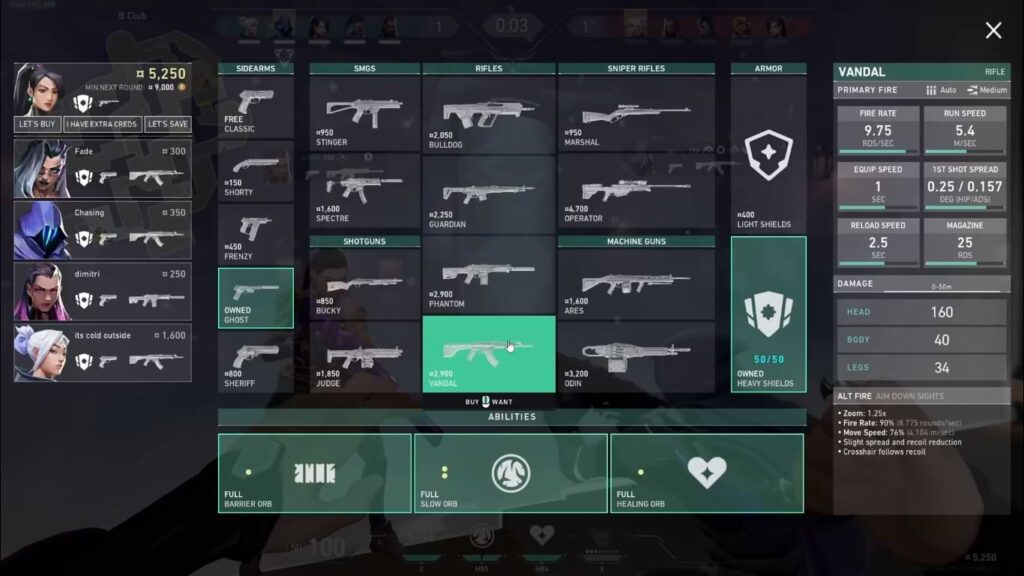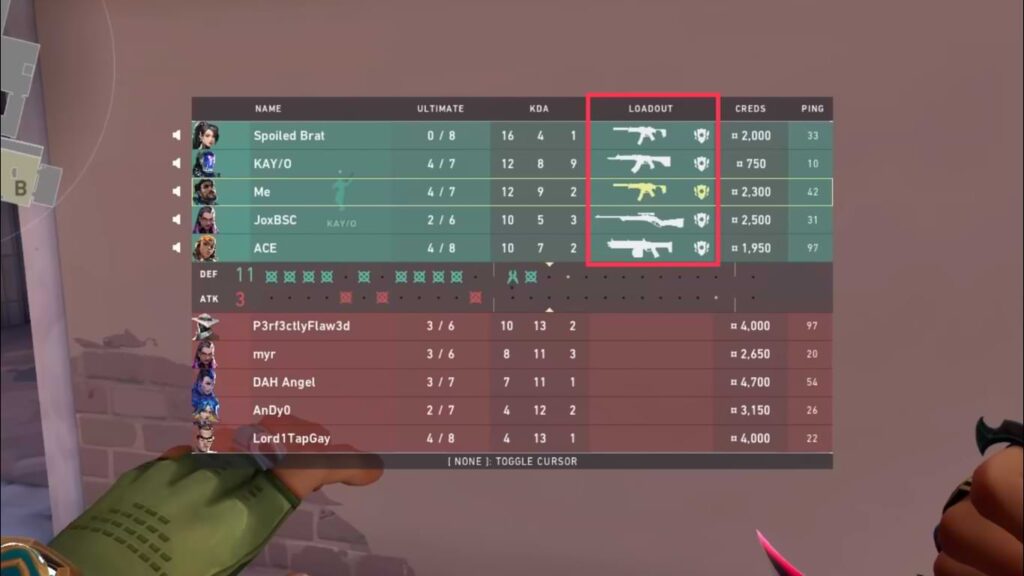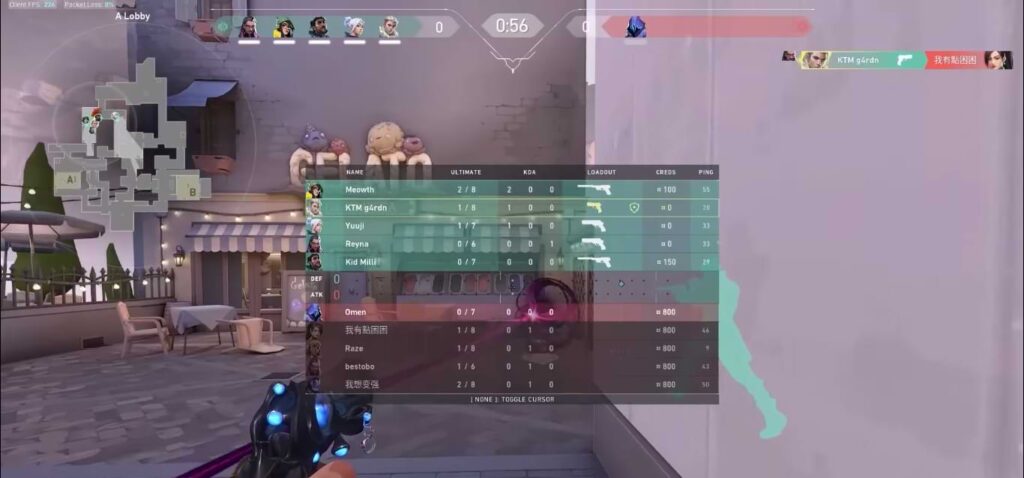The economy in Valorant is something known to all players, but not many truly understand how it works. We are going to break down everything you need to know to master the economy for Valorant. Managing your valorant economy system correctly can truly be the difference between winning or losing a game. You need to know when to buy, what to buy, and when to save. The tricky part is that managing your economy will be different for each agent that you play.

Managing the Valorant Economy Guide is one of the most complex things in the entire game but it’s the least talked about and since the game is so momentum-based it plays a crucial factor in winning or losing the game. Starting with a pistol round you will have 800 credits to play with and you’re pissed around will likely be different with each agent. On some agents, it may be good to prioritize utilities while on other agents it may be better to prioritize a frenzy, a shorty, a sheriff, or even a ghost. From the Valorant deadlock agent guide, Valorant agent gecko, and the Harbor Valorant agent guide you can master each of these agents through Valorant boosting.
What are credits and what can they Buy?
The in-game currency in Valorant is known as Credits through which you can purchase abilities, weapons, and shields. Buying any item in Valorant is done in the Buy Phase. This phase is 30 seconds before each round starts, during the first round of a half the time is 45 seconds.
You and other players in the game are granted 800 credits at the start of the match. The number of credits earned that you earn depends upon every kill and round result. A maximum of 9,000 credits can be earned in the match after that all of the earnings will be wasted. As you switch sides, your credits are reset again onto the 800 credits at the end of the half. If include overtime in the match, you will be granted 5,000 credits on each round.
The better guns will cost you more credits as compared to normal weapons. Starting with 800 credits at the start of each round that allows you to purchase only the combination of Sidearms, light shields, and abilities. Earning more credits will make you rich and becoming rich means that you can purchase the best items, abilities, and equipment.
Basics on Economy
While playing the match you will encounter the types of Buys. You will gain 200 credits for every kill that you get, attackers will gain an additional 300 credits for every time the spike is planted, and for every round one you will get 3,000 credits and this concept is slightly different if you lose the round.
Note: On round loss, you will receive 1,900 credits for your first-round loss then 2,400 credits if you lose two rounds in a row, and then 2,900 credits if you lose three rounds in a row.
If you survive but you lose you lose the round you will only gain 1,000 credits. so, make sure not to save unless you have a weapon that’s worth it to save. There are a few different types of rounds that you should know about the economy and we are going to explain each of them so you understand how the money system works in Valorant and what the goal of each round is.

Full Buy Round
A full buy round is a round where the team spends all or most of their credits to purchase the following items in the game.
⦁ Weapons
⦁ Shields
⦁ Abilities
A full buy will typically have a phantom, full shields, and full utility, or Vandal with the same, or possibly even an operator or Odin with a full utility. You will be in a good spot to win the round if you can consistently a full buy across every round.
Half Buy
There is Half buy or light buy and this is when you purchase some weapons or a light shield but enough so you’re able to still have full buy the next round but enough so you will have a decent chance of winning the round. You will typically see the sheriff and light shield or possibly specter, stinger, judge, bulldog or Marshall or possibly some abilities if you can afford it.
Save round
While managing the economy system in Valorant we’ll have a save round and eco round and this is when you are basically completely broke and if you spend any credit, you’ll likely not be able to afford a full buy as a team in the following round. This round is fairly hard to win but you going around like this is not necessarily to win it but it’s more about getting a spike plant for the extra credits if possible and damaging the enemy team’s economy by getting as many kills as possible to force them to have to re-buy their armor, weapon, and utilities in the following buy round.
Force Buy
Force buy is when you use all of your credits to buy anything you can. This is something you will see when it’s a pivotal round in the game. For example, if you and your entire team have only 2,500 credits but the other team is at a match point then you wouldn’t save but instead you would force buy.
It’s the same concept if you and your team win around but you lose a lot of players then you may opt to force buy the next round to try and take the momentum economy-wise. Sometimes you’ll see force buys after losing a pistol round as well because your buys will be fairly similar on attack provided you get a spike planted.
Make sure to communicate with your team and make sure you’re on the same page so that you can force buy together so it’s more effective.
Hero Buy
Hero buys sounds like a pretty foreign concept in the lower ranks of the game. This is essentially when you are feeling yourself in the game and hitting all of your shots and you decide to solo buy on a save round. In the hero buy round, you’re typically solely responsible for being the X factor, meaning if you’re going to do this you need to have a significant impact on the round. Communicate with your teammates when doing a hero buy so they can recycle your purchased weapon in case you die.
Hero buys are done if you notice a specific weakness in the enemy’s play that you feel you can take advantage of to snowball a round in your favor. Maybe you notice the enemy Reyna keeps peeking mid-solo without using utility, and you are going to go and sit her down.
Valorant economy system
At the start of every buy phase, new credits are given to you. You and your teammates will earn different amounts of credits depending on the outcome of the previous round.
⦁ For every kill you will earn 200 credits
⦁ Each player starts with 800 credits in the first round of each half
⦁ 3,000 credits will be earned, once you win the round
⦁ You will earn 3,000 credits each for planting the spike when you’re on the attacker side
When you are losing the round, the credit income varies a lot.
⦁ For each round loss, you and your teammates earn 1,900 credits
⦁ if you’re on a 2x loss streak, you and your teammates get 2,400 credits
⦁ if you’re on a 3x or more loss streak, you and your teammates will earn 2,900 credits
⦁ You will earn 1,000 credits regardless of the loss streak if you survive a round that you lost. If you are about to lose a round then make sure that you die as well, then you’ll be carrying equipment whose values are less than 1,000 credits
Share credits with your teammates
It’s important to note, to watch your teammate’s economy because it’s best to manage your economy in a way that your teammates are not falling behind. For example, if you contain 8,000 credits and your teammates only have 3,500 credits then it’s probably a great idea to buy your teammates since you can only have a Max of 9,000 credits and you will be wasting your credits if you do not spend them.

Econ Rating
Econ rating is basically the damage dealt per 1,000 credits that you spend. Most players don’t know how Econ rating works. If you have a higher econ rating it means you’ve been more efficient with the things that you’ve bought throughout the entire game. The more efficient you are with the things you buy, the higher the Econ rating you have.
For example, if you spend 6,000 credits worth of weapons and utility in a round and deal 600 damage then you will get an econ rating of 100. This statistically doesn’t matter too much but if you have consistently a low econ rating then it probably means that you are spending too much on rounds that you have zero business of winning like possibly force buying without your team. If you’re overspending in the round that will result in a low Econ rating despite that you are constantly struggling.
Econ Rating = Damage / (Credits * 1000)
Enemy Team economy
The other important thing about understanding the economy is consistently being aware of your enemy’s economy. For example, if you hold a tab then you can see how many credits the enemy team currently has. If they have 2,000 credits, they are likely on a save round and will be playing with bad weapons like a shorty, classic, or sheriff which means they’re most likely to play close angles to try and get a kill.
Being aware of another team economy will allow you to use utility to clear out the same close angles just like a Sova drone or Skye Dog. It’s the same concept if you see a Jett on the other team, for example, saved up 6,000 credits. There will be a great possibility that they have saved for an OP knowing this, you can use your utility to try and bait out an OP shot so that you don’t get caught off guard by this OP and give the enemy team an early advantage.
Second Round Buy
Second round buy is if you win the piston round then stop saving since Valorant is a very momentum-based game. The only time you typically want to be saving a pistol instead of buying after winning the pistol round is if you are saving to have an off in the third since the enemy team will likely be on pistols then you don’t take advantage of your economy advantage is basically griefing your team.
You always want to string as many rounds together as possible so you can have a strong and healthy economy and if half of your team is saving after winning a pistol while half it is buying then you’re going to have a really bad economy in the following round forcing you to save and just like that your 1-0 lead now turned to a 1-2 deficit and
Valorant Bonus Round
A common misconception is that you don’t buy a second round because in the third round, it will be a full buy but instead, if you want full buy in the second round after winning your pistol round your third round will become your bonus round. Winning this round will put you and your teammates at a huge economic advantage going into the fourth round as the other team will be completely broke and you will gain a bunch of credits and probably free vandals and phantoms but the goal isn’t specifically to win a bonus round.
Since it’s the enemy team’s first full buy if you can take even four players down with you, your following round will be stronger than the enemy team’s buy meaning they will likely have to force by with half shields or less utility in the following round, setting you up so if you win the fourth round then you’ll start having very healthy economy while the other team is on a save yet again.
Pistol Round Buys
There’s a ton of confusion on pistol rounds and what to buy since it’s different for every agent. Starting with Duelist, if you play Reyna, you’re going to buy a ghost and two devourers. For Raze you want two satchels and light shields. For neon, you will buy Frenzy and Fast Lane. For Jett, you want a ghost and one smoke. For Phoenix, you will buy a ghost and one flash. For Yoru, you will buy a ghost and one flash.
In initiators, For Sova, you will buy light shields and a drone. For Fade you have to spend credits on buying two prowlers. For Kay/O you will buy a ghost and for Breach, Two Flashes, and Aftershock. For Gekko, you want a light shield and a wingman. For Skye, you want a heel and your Trailblazer.

In Controllers, For Brimstone, you want to buy two smokes and a ghost. For Astra, two stars and light shields. For Viper two snake bites and light shields. For Harbor, two cascades and a cove. For Omen you want to buy Paranoia, smoke, and light shields. For the chamber, One trip and forehead hunter shots. For Cypher, you want to buy one cage, one trip, and a ghost. For Killjoy you will spend your credits to buy one Molly and a ghost. For Sage, two slows and a wall. For Deadlock, you will buy two Sonic Sensors and light shields.
Agent Buy
If you typically play an agent like Reyna or Jett, most of your utility isn’t as important as all of the other agents. so, what high-level players will do is buy light shields and a vandal or phantom. You can typically do this and still afford to buy another light shield, vandal, or phantom.
The next round if you’re on max loss bonus then this allows you to constantly have a rifle without any major cons other than the fact that the phantom can one bullet you at medium range. It’s also important to remember that the phantom will only hit you for 124 long range if you buy a light shield and a vandal for long-range fights then you may put yourself at an advantage and this will allow your team to win rounds that were otherwise unwinnable.
Conclusion
Based on the performance of the previous round, and the number of credits saved from the previous rounds of the current half, the number of credits is awarded to each player. Try to spend less amount of credits for your damage as it will have a positive impact on the econ rating. You must learn what to save the credit, when to use it, and when to force buy. Keep a keen eye on the enemy team’s economy as well.
FAQs
A cheap pistol that has high accuracy is Ghost or Sherrif and might be the best choice unless you have to full-save an eco-round to hit 4,000 minimum credits.
When your economy is best position buying heavy armor (600 credits) won’t disturb your economy.
You need to Spend fewer credits for your damage, as a result, the econ rating will be high.
The best rating for Econ is always 100 and above.